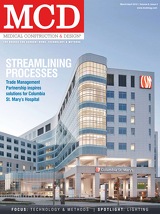Medical Construction & Design (MCD) is the industry's leading source for news and information and reaches all disciplines involved in the healthcare construction and design process. To view more past issues go to: http://mcdmag.epubxpress.com
Page 38 of 70
improvements both systemic and sustainable in healthcare and in health. In this model, systemic means pattern changing and sustainable means progressively improving over time. Necessarily, to reframe the current situation and to pioneer a step toward a new approach is the work of leaders, in healthcare design, as in every industry and walk of life. This approach to designing healthcare en- vironments is achieved through a learning process that focuses on increasing mastery in the 22 themes that form the practice of health-design leadership. Practitio- ners of this new method focus on every single person within any context as a potential leader, recognizing that leadership happens only when it is being actively exercised — acknowledging that when it is not being exercised, nothing happens. "Creating a place to fl ourish" is the outcome of practicing this approach. Flourishing is a completely subjective state that requires attention to developing new metrics that identify and capture subjective hopes and experience in tangible outcomes. This is the basis for the continued learning of the Generative Space practitioner, the sustainable improvements that provide the conditions for progressive fl ourishing, and the ac- countability that leadership is being effective in deliver- ing its overall organizational vision.
In this new model, each leader at every level is involved in design of the fully integrated environment to create a complete experience that represents the opportunity to fl ourish for all consistent stakeholders. The range of stakeholders is wholly inclusive: from the patients and their families, loved ones and visitors; to all staff, employees, consultants, vendors and trades- people; to the entire local community. As each leader "actively exercises health design leadership to cultivate
a more generative space," they are designing both physical environments and social experiences that cor- respond with each and every stakeholder's expectation of how "a place to fl ourish" should feel. This new generation of leadership is termed "health design leadership" because it uses the practice of design to create states of improved personal health.
The research and generative space process led to a solution inspired by a simple fl ower. The core symbolizes the Arlington Free Clinic's life-enhancing and systemic mission. The conceptualized petals illustrate the components of Arlington Free Clinic: welcome (reception and waiting), treat (medical and behavioral healthcare), support (staff and fundraising services) and community (educating and engaging patient and volunteer communities).
34 Medical Construction & Design | March/April 2012 www.mcdmag.com
